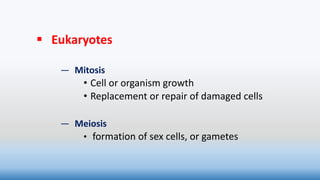This document discusses the cell cycle and cell division. It begins by defining cell division and the three main types: binary fission in prokaryotes, mitosis in eukaryotes for growth and repair, and meiosis in eukaryotes for formation of gametes. The stages of the cell cycle are then described, including interphase (G1, S, G2 phases) and the mitotic phase. The mitotic phase involves the four stages of mitosis (prophase, metaphase, anaphase, telophase) followed by cytokinesis. Key checkpoints in the cell cycle that regulate division are also mentioned.








![EUKARYOTIC CELL DIVISION
• Cell division that results in two daughter cells each having the same
number and kind of chromosomes as the parent cell
1. MITOSIS
• Two (2) main steps:
1. Mitosis
Fours steps; [Prophase>Metaphase>Anaphase>Telophase]
2. Cytokinesis
Cytoplasm divides forming two new daughter cells
• Each daughter cell is Genetically Identical to parent cell](https://image.slidesharecdn.com/2-190118112234-220912025328-b7268764/85/2-190118112234-pdf-9-320.jpg)

![Eukaryotic Cell Division Cont.
• Cell division that results in four daughter cells
2. MEIOSIS
• Two (2) major steps:
1. Mitosis
Fours steps; [Prophase>Metaphase>Anaphase>Telophase]
2. Cytokinesis
Cytoplasm divides forming two new daughter cells
• Each daughter cell is NOT Genetically Identical to parent cell](https://image.slidesharecdn.com/2-190118112234-220912025328-b7268764/85/2-190118112234-pdf-11-320.jpg)





















![REFERENCE
• Nabor, Murray W., INTRODUCTION TO BOTANY. Copyright 2004 Pearson
Education, Inc., Publilshing as Benjamin Cummings, 1301 Sansome St., San
Francisco, CA 94111.
www.aw-bc.com
• CK – 12
https://www.ck12.org/biology/cell-division/lesson/Cell-Division-BIO/
• Image Attributions
[Prokaryotic cell division]
Credit: Mariana Ruiz Villarreal (LadyofHats) for CK-12 Foundation
Source: CK-12 Foundation
License: CC BY-NC 3.0](https://image.slidesharecdn.com/2-190118112234-220912025328-b7268764/85/2-190118112234-pdf-33-320.jpg)